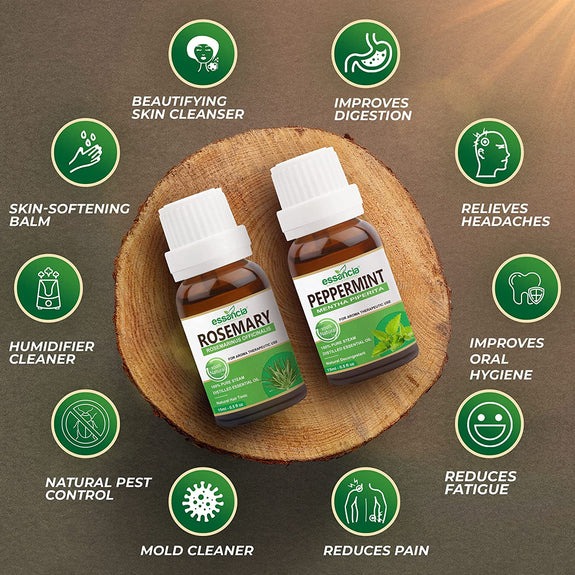HERB - Introduction to the Versatility and Benefits of Herbs
Peppermint: A Natural Remedy for Pain Relief and Digestive Issues
Peppermint is a popular herb that has been used for centuries for its medicinal properties. It is known for its refreshing aroma and cool, minty flavor, which is why it is often used in chewing gums, toothpaste, and other food and cosmetic products. Peppermint is also a potent herb that can provide relief for a variety of health conditions, including pain and digestive problems. In this article, we will explore the many medicinal uses of peppermint, its alternative treatments, and how to use it for optimal results.
Part 1: Medicinal Properties of Peppermint
Peppermint has many medicinal properties that make it a popular choice for alternative treatments. Some of its most notable properties include:
- Pain Relief: Peppermint has natural pain-relieving properties that can help alleviate headaches, muscle pain, and joint pain. It works by inhibiting the release of prostaglandins, which are responsible for causing pain and inflammation in the body.
- Digestive Aid: Peppermint can be used to treat a variety of digestive problems, including bloating, gas, nausea, and indigestion. It works by relaxing the muscles in the digestive tract, which can help improve the flow of bile and other digestive juices.
- Anti-Inflammatory: Peppermint has anti-inflammatory properties that can help reduce inflammation in the body. This can be particularly beneficial for individuals suffering from inflammatory conditions such as arthritis and asthma.
- Antimicrobial: Peppermint has antimicrobial properties that can help fight against harmful bacteria, viruses, and fungi. This can be particularly beneficial for individuals suffering from infections and other immune-related disorders.
- Respiratory Aid: Peppermint has a cooling and soothing effect on the respiratory tract, making it an effective remedy for respiratory problems such as coughs, colds, and congestion.
Part 2: Medicinal Uses of Peppermint

Peppermint can be used for a variety of medicinal purposes. Some of its most common uses include:
- Pain Relief: Peppermint oil can be applied topically to alleviate headaches, muscle pain, and joint pain. It can also be ingested in tea or capsules to provide systemic pain relief.
- Digestive Aid: Peppermint tea can be consumed after meals to help improve digestion and relieve symptoms of bloating, gas, and indigestion.
- Anti-Inflammatory: Peppermint oil can be applied topically to alleviate symptoms of arthritis, asthma, and other inflammatory conditions.
- Antimicrobial: Peppermint oil can be used as a natural disinfectant to clean wounds and prevent infections. It can also be used to treat fungal infections such as athlete’s foot and ringworm.
- Respiratory Aid: Peppermint tea or oil can be used to alleviate symptoms of respiratory problems such as coughs, colds, and congestion.
Part 3: Alternative Treatments with Peppermint
Peppermint can be used in a variety of alternative treatments to provide relief for different health conditions. Some of the most common alternative treatments with peppermint include:
- Aromatherapy: Peppermint essential oil can be used in aromatherapy to provide relief for headaches, anxiety, and other emotional and mental health conditions.
- Massage Therapy: Peppermint oil can be used in massage therapy to provide relief for sore muscles, joint pain, and tension headaches.
- Herbal Remedies: Peppermint tea and capsules can be used as a natural remedy to provide relief for digestive problems, respiratory problems, and pain.
- Skincare: Peppermint oil can be used in skincare products to provide a cooling and soothing effect on the skin. It can also be used to treat acne and other skin conditions.
Peppermint oil can help relieve tension headaches and migraines.
One of the most common uses of peppermint oil is for relieving tension headaches and migraines. Peppermint oil is known for its cooling and soothing properties, which can help ease the pain and discomfort associated with these types of headaches.
To use peppermint oil for headaches, you can mix a few drops with a carrier oil, such as coconut oil or almond oil, and apply it to your temples and the base of your neck. You can also inhale peppermint oil by adding a few drops to a bowl of hot water and inhaling the steam.
Peppermint tea can help soothe an upset stomach and aid digestion.
Peppermint tea is a popular remedy for soothing an upset stomach and aiding digestion. The menthol in peppermint tea can help relax the muscles in the digestive tract, which can relieve symptoms such as bloating, gas, and indigestion.
To make peppermint tea, you can either use fresh peppermint leaves or peppermint tea bags. Steep the leaves or bags in hot water for several minutes, then strain and drink.
Peppermint can help relieve menstrual cramps.
Peppermint has antispasmodic properties, which can help relax the muscles in the uterus and relieve menstrual cramps. Peppermint tea or oil can be used to help ease the discomfort associated with menstrual cramps.
To use peppermint oil for menstrual cramps, you can mix a few drops with a carrier oil and massage it into your lower abdomen. You can also add a few drops of peppermint oil to a warm bath and soak for 20-30 minutes.
Peppermint can help relieve symptoms of irritable bowel syndrome (IBS).
Peppermint oil has been shown to be effective in reducing symptoms of irritable bowel syndrome (IBS), such as abdominal pain, bloating, and gas. The menthol in peppermint oil can help relax the muscles in the digestive tract, which can reduce symptoms and improve overall digestive function.
To use peppermint oil for IBS, you can mix a few drops with a carrier oil and massage it into your abdomen. You can also take peppermint capsules, which are available at most health food stores.
Peppermint can help relieve symptoms of colds and flu.
Peppermint has antiviral, antibacterial, and anti-inflammatory properties, which can help relieve symptoms of colds and flu. Peppermint tea or oil can be used to help ease symptoms such as congestion, coughing, and sore throat.
To use peppermint oil for colds and flu, you can add a few drops to a bowl of hot water and inhale the steam. You can also mix a few drops with a carrier oil and massage it into your chest and throat area.
Peppermint can help improve mental clarity and focus.
Peppermint has a refreshing and invigorating scent that can help improve mental clarity and focus. Inhaling peppermint oil can help stimulate the brain and improve cognitive function, making it a great natural remedy for mental fatigue and lack of focus.
To use peppermint oil for mental clarity, you can add a few drops to a diffuser or inhale the scent directly from the bottle. You can also mix a few drops with a carrier oil and massage it into your temples.
Peppermint can help relieve stress and anxiety.
Peppermint has a calming and soothing effect on the mind and body, making it a great natural remedy for stress and anxiety. Inhaling peppermint oil can help reduce feelings of anxiety and promote relaxation.
To use peppermint oil for stress and anxiety, you can add a few drops to a diffuser or inhale
How to use Peppermint for pain relief and digestion

Peppermint can be used in a variety of ways to help alleviate pain and improve digestion. Here are some common methods of using peppermint for these purposes:
Peppermint tea
Peppermint tea is a popular and easy way to enjoy the benefits of peppermint for pain relief and digestion. To make peppermint tea, simply add one teaspoon of dried peppermint leaves to a cup of boiling water, cover the cup, and let it steep for 10-15 minutes. Strain the leaves and enjoy the tea. You can sweeten the tea with honey or add a slice of lemon for added flavor.
Peppermint essential oil
Peppermint essential oil can be used topically to relieve pain and muscle tension. Dilute the essential oil with a carrier oil such as coconut oil, and apply it to the affected area. You can also inhale peppermint oil by adding a few drops to a diffuser or a bowl of hot water.
Peppermint capsules
Peppermint capsules can be taken orally to help relieve digestive issues such as bloating and gas. Follow the instructions on the label for the recommended dosage.
Peppermint leaves
You can also use fresh peppermint leaves in your cooking or add them to your smoothies for added flavor and health benefits.
Precautions and side effects
While peppermint is generally safe for most people, there are some precautions and potential side effects to be aware of:
- Peppermint may cause heartburn or acid reflux in some people.
- Peppermint essential oil should be used with caution, as it can be toxic in large doses.
- Peppermint oil should not be used on or near the face of infants or young children, as it can cause breathing difficulties.
- If you are pregnant, breastfeeding, or have a medical condition, consult with your healthcare provider before using peppermint.
Conclusion

Peppermint has been used for centuries as a natural remedy for pain relief and digestive issues. Its active ingredient, menthol, has analgesic and anti-inflammatory properties that make it effective in alleviating pain and reducing inflammation.
Peppermint also has antispasmodic properties that can help relax muscles and ease digestive discomfort. Whether you prefer to drink peppermint tea, use peppermint essential oil, or take peppermint capsules, there are many ways to incorporate this versatile herb into your daily routine. As with any natural remedy, it is important to use caution and consult with your healthcare provider before using peppermint if you are pregnant, breastfeeding, or have a medical condition.











